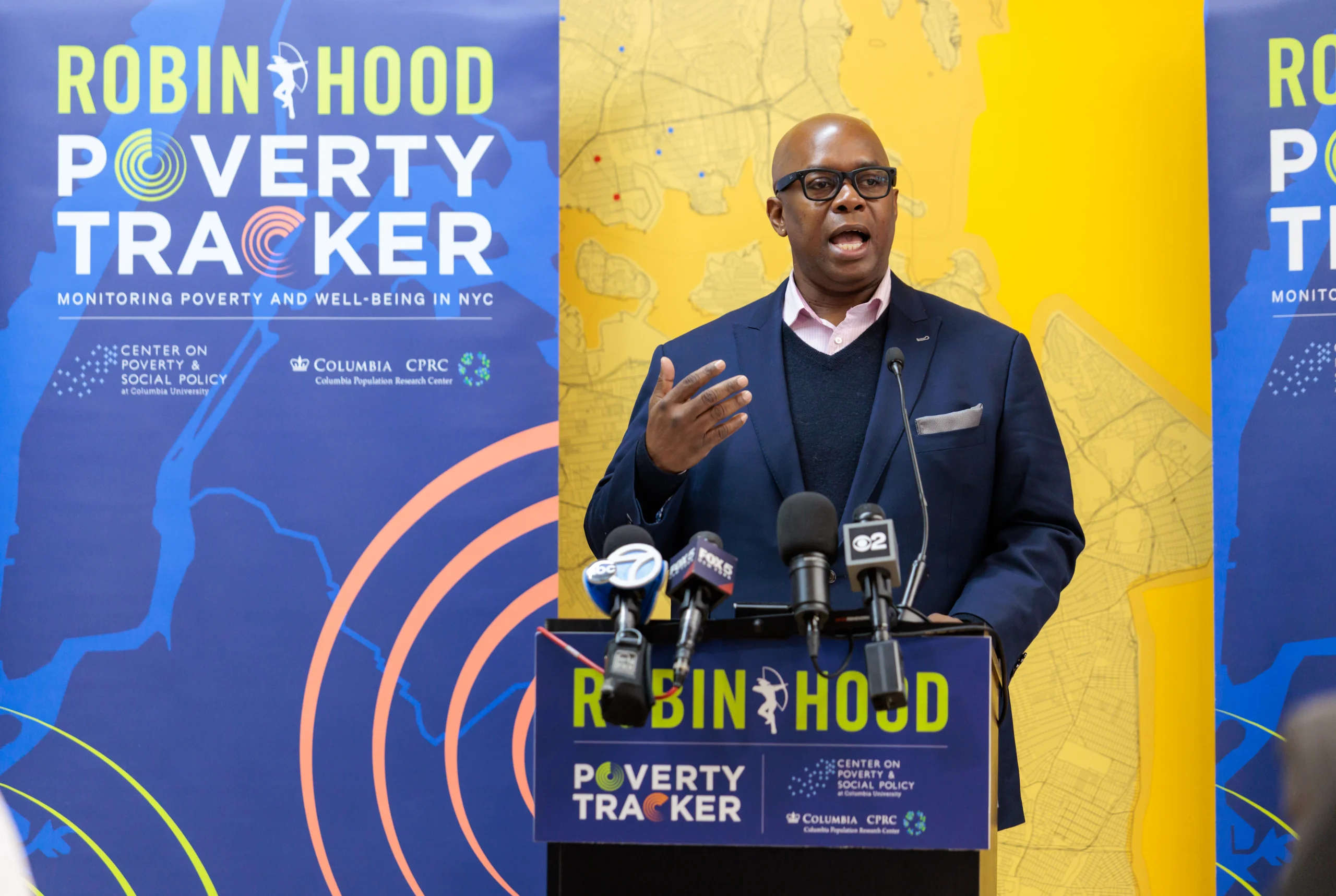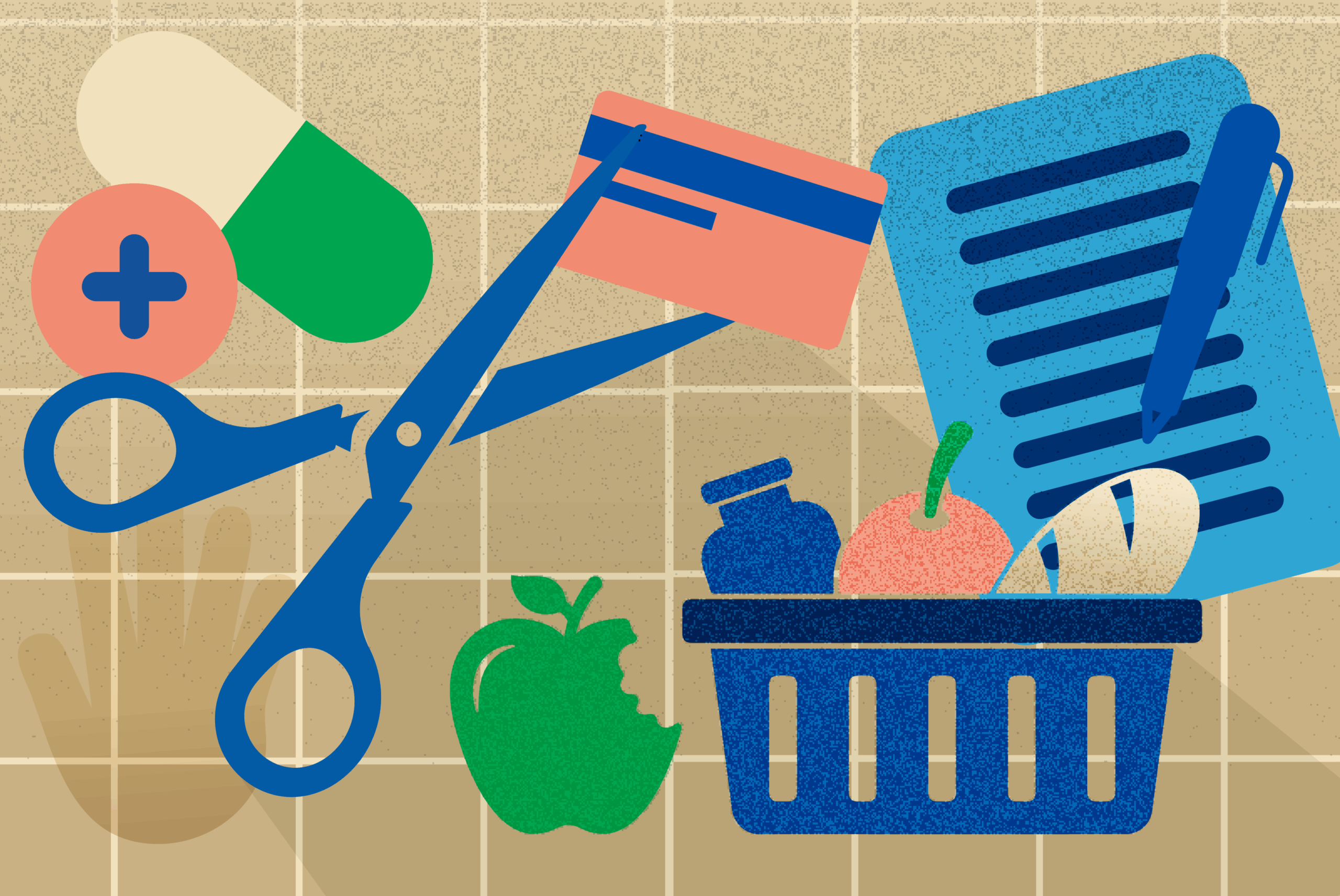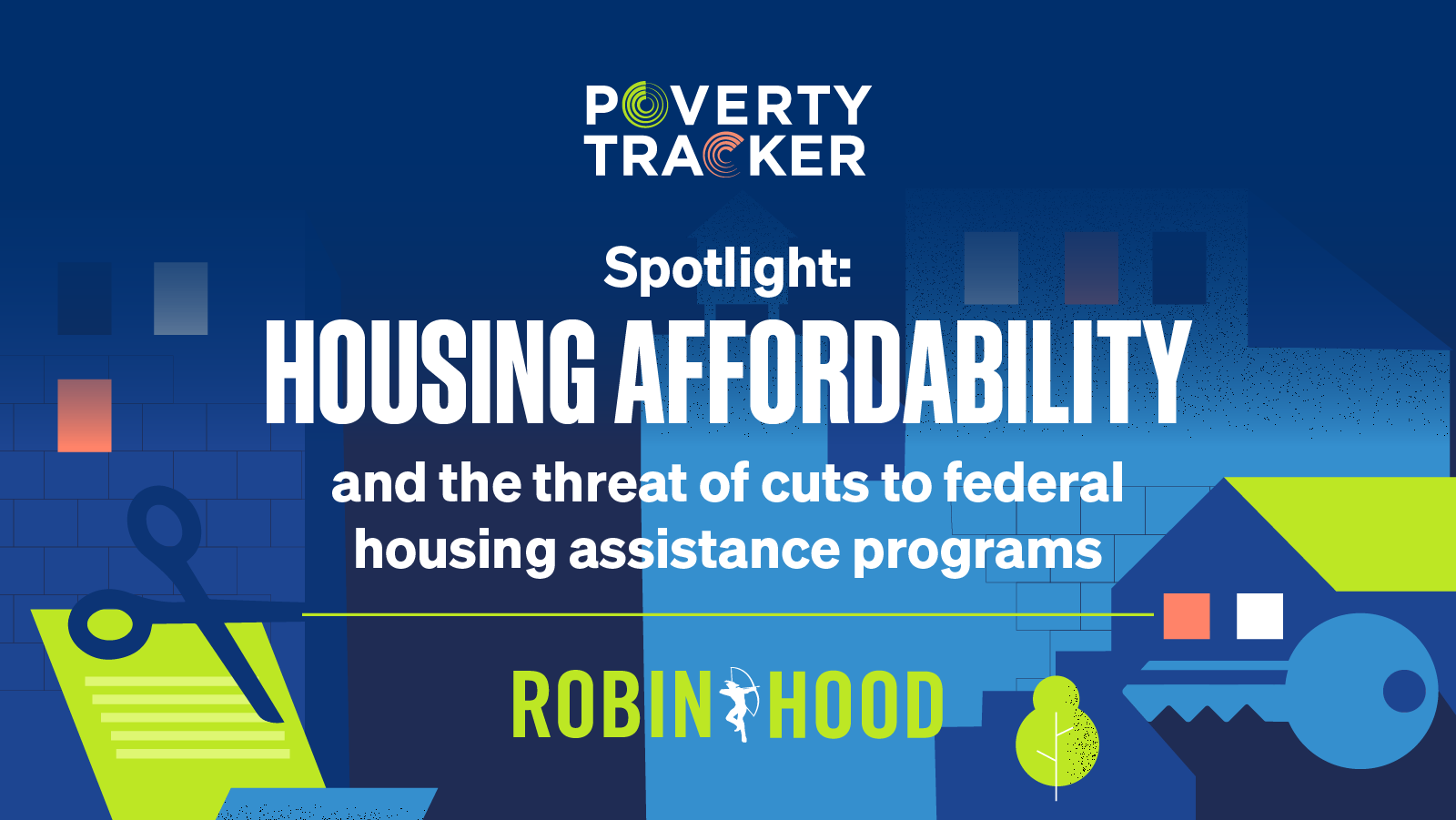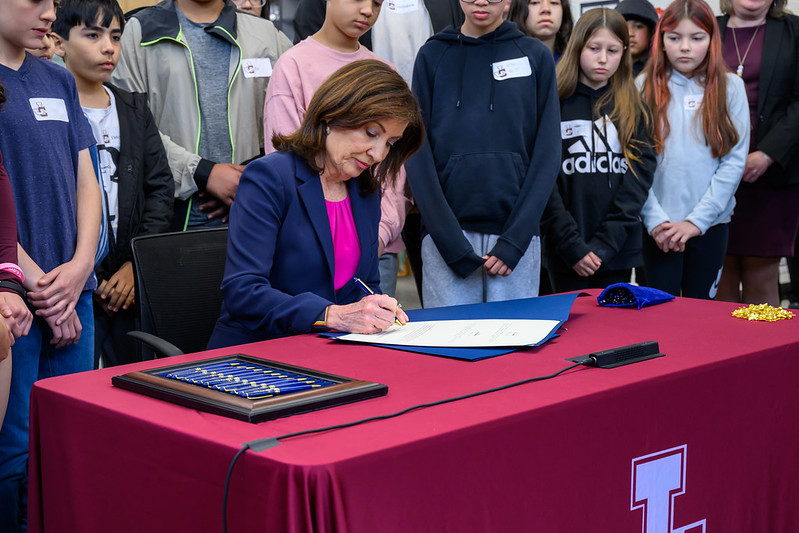Jan 13, 2022 Press Release
New Poverty Tracker Report Finds New York City at Risk of Massive Increase in Evictions and Homelessness
Nearly 1 in 4 New York City renters missed a rent payment in the past year. Research shows expansion of CityFHEPS rental vouchers could cut city’s poverty rate by >20%.
Today, Robin Hood, in collaboration with Columbia University’s Center on Poverty and Social Policy and the Columbia Population Research Center, released its latest Poverty Tracker report on New York’s housing crisis. The data demonstrates that with New York State’s eviction moratorium scheduled to expire on January 15th, New York City is at risk of a massive increase in evictions and homelessness as New Yorkers who lost employment income due to the COVID-19 pandemic are 50% more likely to be behind on rent now compared to pre-pandemic levels and— in total—nearly 1 in 4 New York City renters missed a rent payment in the past year.
The Poverty Tracker report demonstrates that this looming eviction wave is not simply a symptom of the pandemic, but instead an escalation of a long-standing affordability crisis that has long left New Yorkers vulnerable to missing rent payments and facing eviction. To address the long-term affordability crisis and help households remain stably housed, the report models out the potential impact of reforming and expanding the CityFHEPS voucher program, which could cut the city’s poverty rate by over 20%.
“Make no mistake: a wave of evictions is coming that will put hundreds of thousands of New Yorkers at risk. This report shows exactly who will be crushed by this crisis — overwhelmingly New Yorkers of color and our lower-income neighbors who were already facing housing instability before the pandemic — and lays out a path to help them while reducing poverty by over 20 percent,” said Richard R. Buery, Jr., CEO of Robin Hood. “The causes of this crisis are myriad, and solutions must be, too — from improving rental vouchers so they better prevent evictions and enable more New Yorkers living in shelters to move into permanent housing faster over the long term, to providing emergency funding today. Right now, our city, state, and federal leaders have an opportunity to make meaningful policy changes that address both the new and longstanding housing challenges our neighbors face. This would be a major investment — but preventing the vicious cycle of generational poverty that comes from evictions and homelessness is worth every dollar.”
Report Findings
- The likelihood of falling behind on rent rose by 50% for those who lost employment income because of the pandemic, leaving them at a much higher risk of eviction today than in 2019.
- For New Yorkers who did not lose their jobs, many were able to save money and improve financial stability by reducing expenses during the pandemic. Among this group, 15% fell behind on rent compared to 17% pre-pandemic, marking a widening gap in housing stability across New York City.
- Poverty Tracker data demonstrates that this looming eviction cliff is not simply a symptom of the pandemic, but instead an escalation of a long-standing affordability crisis that has long left New Yorkers vulnerable to missing rent payments and facing eviction.
- Before the pandemic, 41% of all renters in New York and 67% of those living in poverty were rent burdened, defined as paying more than 30% of their gross income on rent.
- Systemic policy and economic factors have led Black and Latino New Yorkers to be disproportionately affected by the housing affordability crisis even before the pandemic, with these groups facing above average rates of rent burden. Lifting the eviction moratorium will likely have an outsized effect on Black and Latino New Yorkers, deepening economic and racial segregation in the city.
- On average, roughly 44% of Black New Yorkers and 45% of Latino New Yorkers were rent burdened before the pandemic, versus 39% of white New Yorkers.
- Earlier Poverty Tracker analyses also found that Black and Latino New Yorkers were more likely than white New Yorkers to lose employment income due to the pandemic, which was also true at the national level.
- When interviewed in the summer and fall of 2021, 1 in 4 Black or Latino New Yorkers reported being unable to make a rent payment or owing back rent to their landlord, compared to just 1 in 10 white New Yorkers.
Policy Solutions to Housing Crisis
Since COVID-19 began, government policies like the eviction moratorium, rental assistance programs, and other pandemic-related relief policies have so far prevented a swell in eviction filings—weekly eviction filings in New York City for 2020 and 2021 were well below historical averages. However, these policies and programs have either exhausted their funding, already expired, or will soon.
“With the expiration of the state’s eviction moratorium, an eviction crisis in New York City looms. But our data shows that the roots of this crisis lie in the persistently high housing costs that low-income renters in the city have faced for years,” added Sophie Collyer, Research Director of the Center on Poverty & Social Policy at Columbia University. “Preventing evictions in the short- and long-run will require far-reaching policies that address the city’s long-standing housing affordability crisis.”
In New York City, the CityFHEPS rental voucher program is hampered by its overly strict criteria and policy design that helps families only after a housing crisis, rather than preventing evictions in the first place. To harness the opportunity presented by CityFHEPS and to address its limitations, Robin Hood, the Century Foundation, and Next100’s From Crisis to Opportunity report proposes targeted reforms that would allow the program to prevent evictions and promote housing stability by expanding eligibility.
This report assesses the potential impact of such changes, finding that a revised CityFHEPS program ultimately could reduce the city poverty rate by up to 23% and the poverty rate among CityFHEPS recipients by 39%. This translates to moving more than 400,000 New Yorkers out of poverty, making CityFHEPS one of the most effective poverty-fighting policies available to New Yorkers.
“The eviction moratorium was a band-aid solution for chronic housing instability in New York City – our tenants need more sustainable fixes that address the root causes of homelessness that existed long before the pandemic. Common sense proposals, like rental vouchers that reflect the true cost of living in New York, can combat entrenched economic and racial inequality,” added Scott Short, the CEO of RiseBoro Community Partnership, a Robin Hood grantee.
Since 2012, the Poverty Tracker has surveyed a representative sample of New Yorkers every three months, providing critical information on the dynamics of poverty and other forms of disadvantage in the city while tracking data on employment, assets and debts, and health. The Poverty Tracker has monitored the impacts that COVID-19 and the related economic downturn has had on life in New York City since the onset of the pandemic.
Read the full report HERE.
. . .
About Robin Hood:
Robin Hood has been fighting poverty in New York City since 1988. Because Robin Hood’s board covers all overhead, 100% of every donation goes directly to the poverty fight. Last year, Robin Hood awarded $172 million in grants, filling a critical void during the COVID-19 pandemic by providing cash assistance, meals, housing, healthcare, education, and other urgent needs to one million New Yorkers impacted by COVID-19, as well as funding an array of programs and initiatives developed to elevate families out of poverty in New York City. Follow the organization on Twitter @RobinHoodNYC and learn more at www.robinhood.org.
About the Center on Poverty and Social Policy (CPSP):
The Center on Poverty and Social Policy at the Columbia School of Social Work produces cutting-edge research to advance our understanding of poverty and the role of social policy in reducing poverty and promoting opportunity, economic security, and individual and family-wellbeing. The Center’s work focuses on poverty and social policy issues in New York City and the United States.
About Columbia Population Research Center (CPRC):
The Columbia Population Research Center supports population health researchers across Columbia University, galvanizing new interdisciplinary and cross-campus collaborations, promoting the professional development of junior scientists, and enabling members to do work that is more innovative and impactful. Our members’ interests encompass four primary research areas: Children, Youth, and Families; Reproductive Health and HIV/AIDS; Immigration/Migration; and Urbanism, with cross-cutting attention to inequalities and policies to mitigate those inequalities.
About RiseBoro Community Partnership:
Since 1973, RiseBoro Community Partnership has offered services designed to support every generation and meet the needs of communities. Its unique model of holistic community revitalization works by developing neighborhood assets, like affordable housing, to create the foundation for a more vibrant and diverse community. With funding from Robin Hood, RiseBoro has played a key role in supporting New Yorkers struggling with housing. That included the launch of a new housing hotline for immigrant families seeking legal assistance and referrals to financial resources available through programs including New York State Emergency Rental Assistance Program (ERAP) and FASTEN (Funds & Services for Tenants Experiencing Need).
Media Contact
Amijah Townsend-Holmes
atownsend-holmes@skdknick.com



